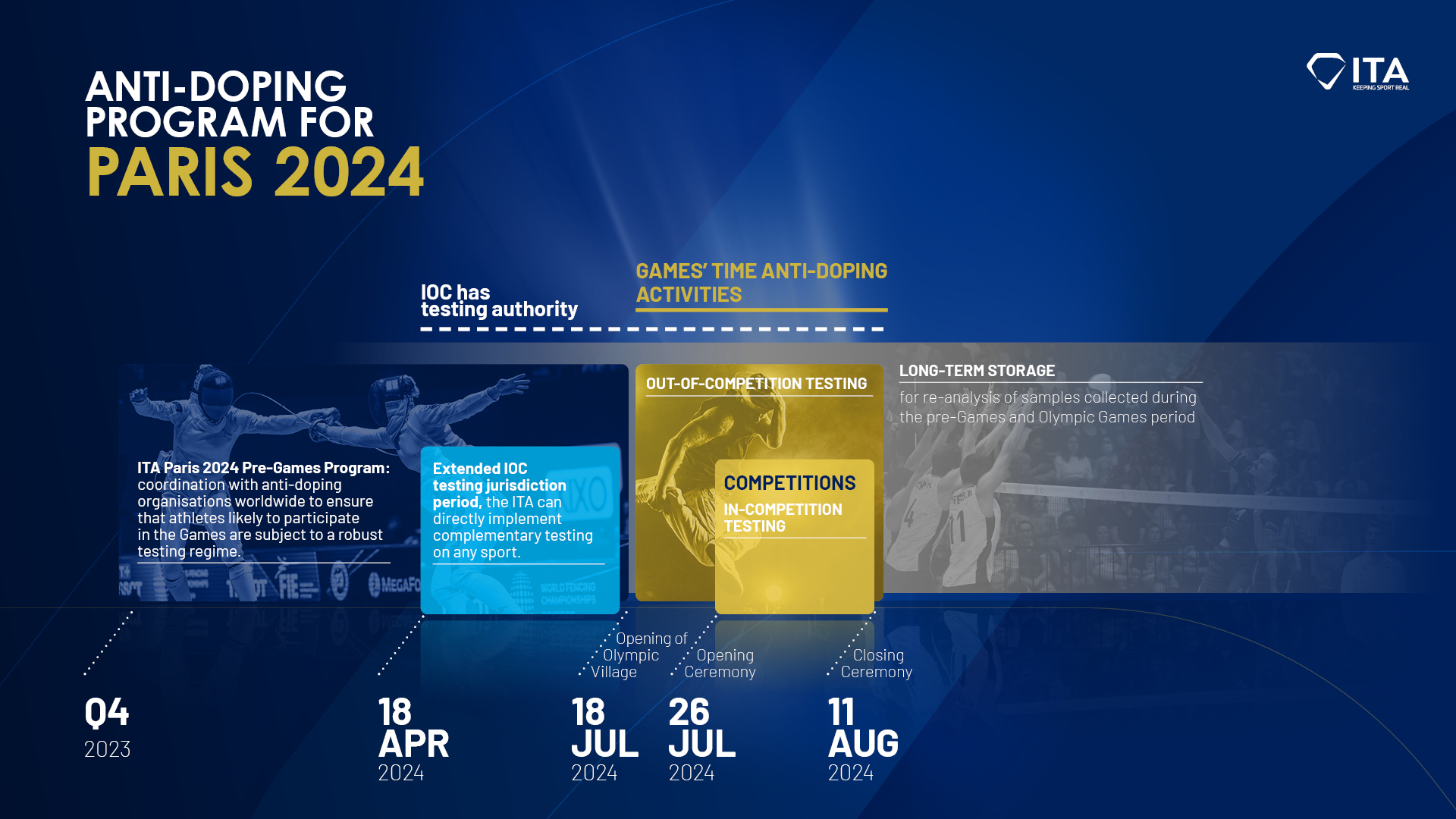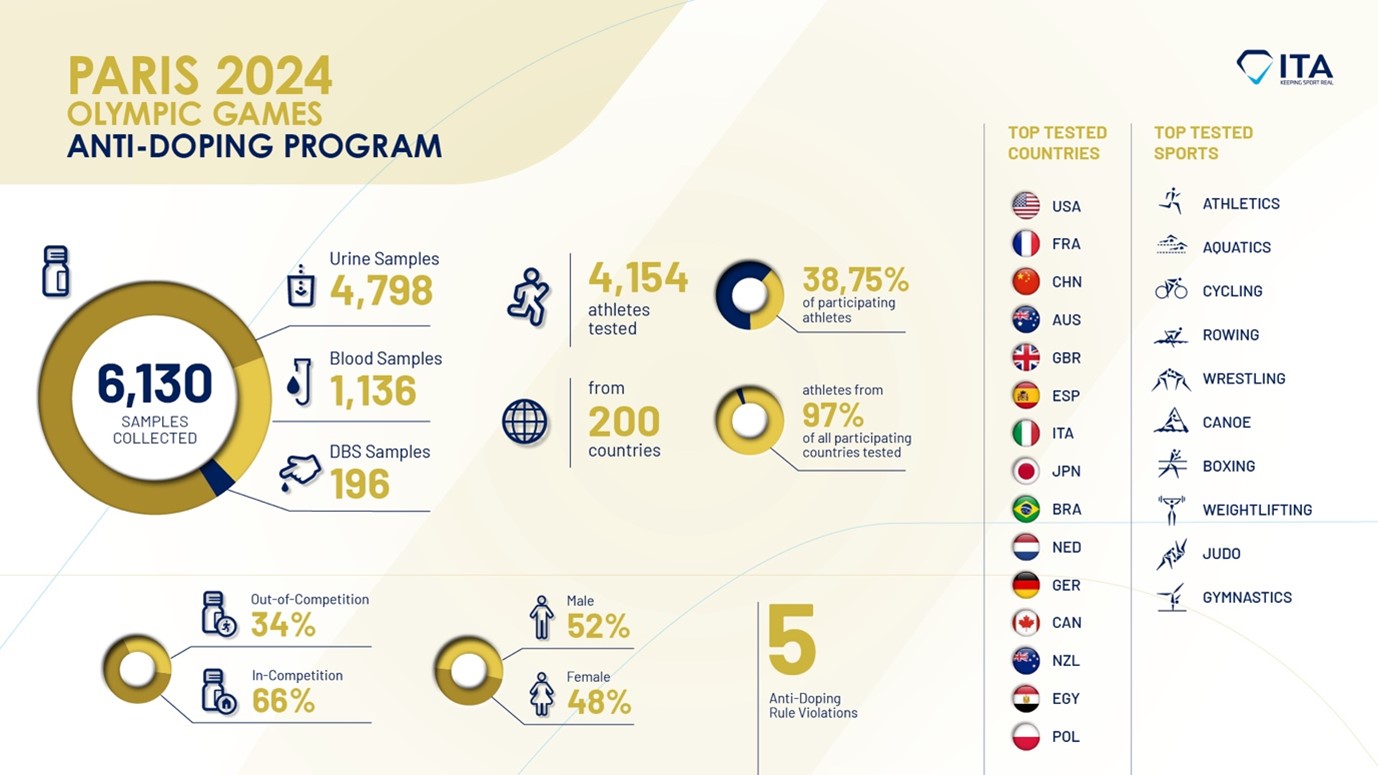Menu

Long-Term Storage – samples of ADOs participating in the LTS program are stored in a centralised facility, as well as all samples collected by the ITA during Games-time.
A total of 6’130 collected samples from over 4’770 doping controls, and for the first time almost 39% of the participating athletes tested at least once – these are the final figures of the ITA’s anti-doping program for Paris 2024. Five anti-doping rule violations were asserted to this moment as the outcome of ITA’s testing program. The vast majority of doping controls were targeted and followed a quality approach based on an extensive risk assessment, performance, and available intelligence. The last phase of ITA’s comprehensive anti-doping program for Paris 2024 is the long-term storage and later re-analysis of samples collected during and in the lead-up to the Games.
With the conclusion of the Olympic Games Paris 2024 on 11 August, the ITA now wraps up the Games-time phase of its anti-doping efforts for the world’s largest sporting event. Altogether, 6’130 samples were collected both in- and out-of-competition from the opening of the Olympic Village to the Closing Ceremony. Throughout the Games, 6,130 samples – comprising urine, blood, and DBS (Dried Blood Spot) – were collected both in- and out-of-competition, spanning from the opening of the Olympic Village to the Closing Ceremony. These samples stemmed from over 4,770 controls conducted on 4,150 athletes, representing 38.75% of all participants – a 4% increase compared to Tokyo 2020 and 10% higher than Rio 2016. This outcome shows that next to applying all the innovations that the ITA has developed for the Olympic anti-doping program in the past years, such as fully paperless operations or enhanced intelligence and investigations support, it has also managed to increase the efficiency of its clean sport activities for the Games.
The greatest number of tests were implemented on athletes from the largest participating delegations: the United States, France, China and Australia (please find more information in the infographic below). Sports such as athletics, aquatics, cycling, rowing, and wrestling saw the highest number of doping controls. Roughly two-thirds of the tests were conducted in-competition, while one-third were carried out out-of-competition. The ITA’s testing program covered athletes from nearly all participating National Olympic Committees (NOCs), encompassing 200 countries and 97% of nationalities represented at the Games.

The ITA’s Games-time anti-doping operations were preceded by an extensive pre-Games testing program conducted in the six months leading up to the event. This initiative resulted in nearly 90% of all participating athletes undergoing testing at least once before the start of the Games, ensuring a robust anti-doping framework ahead of Paris 2024. The ITA can also report over 40 anti-doping rule violations stemming from the testing activities implemented on behalf of its partners ahead of the Games pertaining to athletes who were likely due to participate.
The ITA’s testing strategy relied on an extensive risk assessment that was conducted prior to the Games and considered a variety of parameters, which factored the specific physiology of the respective sports, individual data pertaining to the athletes as well as country-specific risk levels. Combined with the testing recommendations of the ITA Paris 2024 Pre-Games Expert Group, performance factors and intelligence based on information received through ITA’s confidential reporting platform REVEAL and exchange with the French authorities, Olympic Summer International Federations and other anti-doping organisations, the vast majority of doping controls implemented for Paris 2024 by the ITA were targeted.
Up until today, the ITA has asserted five anti-doping rule violations based on results from samples it collected during Paris 2024. Where applicable, concerned athletes were provisionally suspended, which resulted in their immediate exclusion from participating in any competitions during the Games. Their cases have been passed on to the Anti-Doping Division of the Court of Arbitration for Sport (CAS ADD) and/or their respective federations (or the ITA acting on their behalf) for final adjudication. The analysis for banned substances or methods on the 6’130 collected samples by the WADA-accredited laboratory in Paris has been finalised.
The ITA was present in France with a team of over 30 anti-doping experts to oversee the execution of its clean sport program for the Games, which was carried out in close cooperation with the Organising Committee Paris 2024 and the national anti-doping organisation Agence Française de Lutte contre le Dopage (AFLD). 266 Doping and Blood Control Offers from AFLD and National/Regional Anti-Doping Agencies from around the world, 570 Chaperones and numerous other volunteers contributed to the roll-out of these large-scale doping control operations. The ITA extends its gratitude to all individuals and stakeholders who have contributed to the successful delivery of the Paris 2024 anti-doping program for their support and collaboration. The program was overseen by a team of WADA Independent Observers who monitored its implementation in accordance with the World Anti-Doping Code and WADA’s International Standards.
Innovations introduced for Tokyo 2020 were further enhanced for Paris 2024. The ITA continued to leverage a paperless administration system for doping controls and employed a self-developed rooming application to locate athletes in and outside the Olympic Village for out-of-competition tests. Communication with over 200 National Olympic Committees (NOCs) was facilitated through ADCOM, the ITA’s support platform. Notably, the Dried Blood Spot (DBS) method and gene doping testing were implemented as part of the comprehensive testing and analysis protocol for Paris 2024.
All samples collected during Paris 2024 will be kept in ITA’s Centralised Long-Term Storage Facility (CLTSF) for up to ten years and will be selected for re-analysis by the ITA at a later point in time if and when technological or scientific developments allow for more advanced analytical methods. As the six months leading up to the event were the most critical in regard to doping, the ITA and many other anti-doping organisations involved in the Pre-Games testing program have also selected samples collected during this period for long-term storage.
Following the successful delivery of the Paris 2024 anti-doping program, the ITA will continue to strive for improvement and to work tirelessly for the promotion of clean Games in order to ensure a level playing field for all athletes and looks forward to the implementation of the anti-doping programs for the upcoming Olympic Games Milano-Cortina 2026 and LA28.
2 May 2024

29 January 2024


4 June 2024
